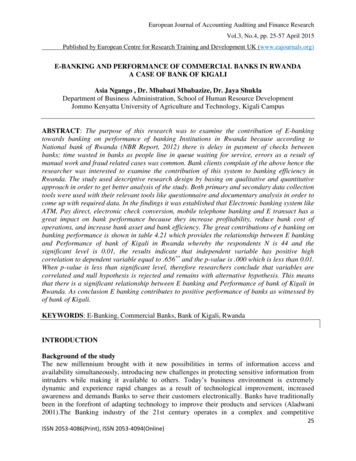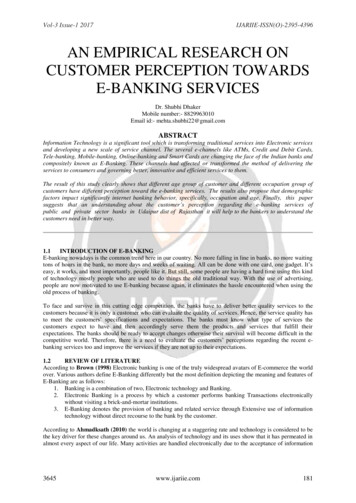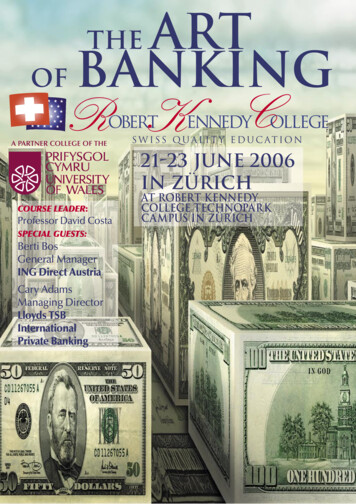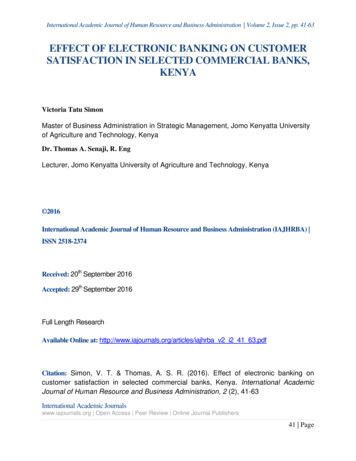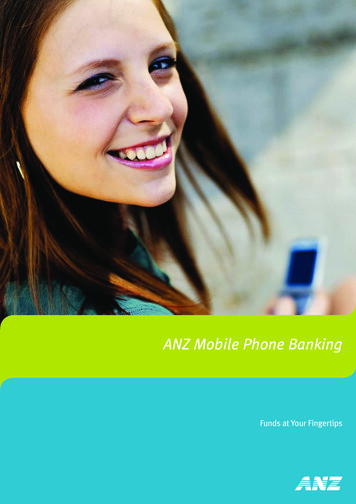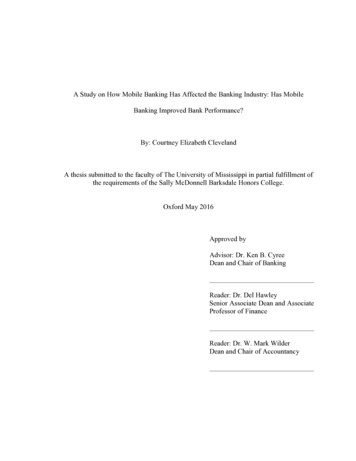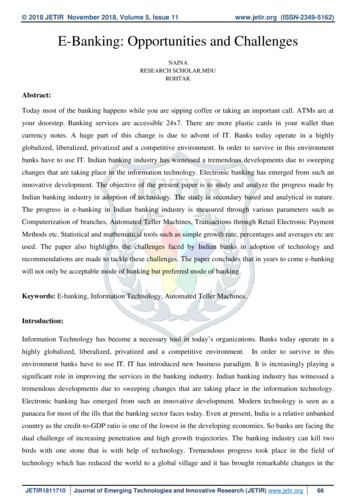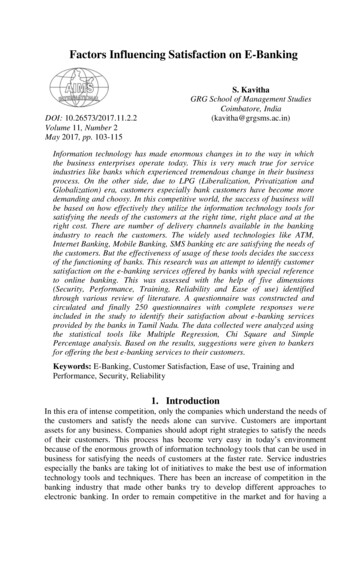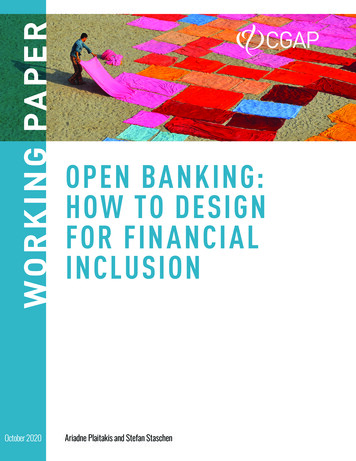
Transcription
OPEN BANKING:HOW TO DESIGNFOR FINANCIALINCLUSIONOctober 2020Ariadne Plaitakis and Stefan Staschen
Consultative Group to Assist the Poor1818 H Street, NW, MSN F3K-306Washington, DC 20433 USAInternet: www.cgap.orgEmail: cgap@worldbank.orgTelephone: 1 202 473 9594Cover photo by Rabin Chakrabarti, 2013 CGAP Photo Contest. CGAP/World Bank, 2020.RIGHTS AND PERMISSIONSThis work is available under the Creative Commons Attribution 4.0 International Public 0/). Under the Creative Commons Attributionlicense, you are free to copy, distribute, transmit, and adapt this work, including for commercialpurposes, under the terms of this license.Attribution—Cite the work as follows: Plaitakis, Ariadne, and Stefan Staschen. 2020. “OpenBanking: How to Design for Financial Inclusion.” Working Paper. Washington, D.C.: CGAP.All queries on rights and licenses should be addressed to CGAP Publications, 1818 H Street, NW,MSN F3K-306, Washington, DC 20433 USA; e-mail: cgap@worldbank.org.
CONTENTSExecutive Summary1Section 1: Introduction2Section 2: Why Open Banking Matters for Poor People6Open banking and financial inclusion6Product innovation7Emerging business modelsSection 3: 12 Design Components1014Components that determine scope14Components related to implementation19Section 4: Implications for Regime Design29Appendix A: Glossary of Terms32Appendix B: Brazilian Open Banking—A Case Study34Appendix C: Mexican Open Banking—A Case Study37References40
AcknowledgmentsThe authors of this Working Paper are Ariadne Plaitakis, senior policy consultant, and StefanStaschen, CGAP senior financial sector specialist. Gregory Chen, CGAP policy lead, oversawthis effort. Peer reviews were provided by Michel Hanouch, CGAP senior financial sectorspecialist, and Xavier Faz, CGAP business models lead. Feedback also was provided byDenise Dias, CGAP senior policy consultant, and Gabriela Zapata Alvarez. CGAP. The authorsthank many other experts who have contributed to the paper, provided feedback, shared theirexperience, or cooperated with CGAP on in-country projects, including: Thiago Alvarez (Guiabolso) Caron Beaton-Wells (Melbourne Business School and Melbourne Law School) Matt Homer (New York State Department of Financial Service) Gavin Littlejohn (FDATA Global) David O’Brian (Meerkat) Diogo Silva (Central Bank of Brazil) Toshio Taki (Money Forward) Joy Wann (BIS)Thanks also go to the Central Bank of Brazil, the Central Bank of Mexico, the Reserve Bankof India, the National Banking and Securities Commission of Mexico, the Superintenance ofPrivate Insurance of Brazil, the Securities and Exchange Commission of Brazil, Sahamati, andmany other stakeholders—including numerous fintech firms—for invaluable insights.DisclaimerAny conclusions or viewpoints expressed in this paper are solely those of the authors. Thefindings, interpretations, and conclusions expressed in this product do not necessarily reflect theviews of CGAP/World Bank, the Executive Directors of the World Bank, or the governments theyrepresent. The World Bank does not guarantee the accuracy of the data included in this work.
1E XECUTIVE SUMMARYOPEN BANKING IS TRANSFORMING THE FINANCIAL SERVICESindustry in advanced economies. By breaking open the data silos of traditional banks,open banking regimes allow fintechs and other innovators to access customer data,including transaction data, and use these data to develop new products and services that arebetter suited to the needs of consumers. For emerging and developing economies (EMDEs),open banking holds out the promise to foster innovation and lower costs in ways that will makeit more economical to serve the underserved and unbanked and offer products and servicesbetter suited to their needs.However, open banking regimes as a means for furthering financial inclusion are largely untestedin EMDEs. To better understand the opportunities and risks, CGAP has conducted a landscapingreview of 12 open banking regimes, including deep dives into seven regimes and two casestudies, to learn how they can be designed to enable products and business models that could bebeneficial for financial inclusion, and how these may alleviate pain points of low-income individuals.Based on this review, CGAP has identified 12 design components that policy makers need toconsider when developing a framework for an open banking regime. Five of these componentsare critical to expanding financial services for poor people, or what we call “financial inclusionby design.” These five design components address:1.Who is required to share data and who can access the data.2.What types of data are shared.3. Which industries are covered (e.g., banking only or utilities and telecoms).4. Whether payment initiation is enabled in the regime.5. Who bears the cost of the regime (including for each data exchange and the set-up of therelevant infrastructure).How these questions are addressed will have a significant impact on a regime’s potential to achievefinancial inclusion objectives. For example, the greater the number of participants required orpermitted to share the data and access them, the greater the diversity of new services that can beenabled, and the more competition that could result. Similarly, the greater the breadth in the types ofeligible data, the more likely that products relevant for low-income individuals can be developed.Since it is still early days for open banking regimes, in particular in EMDEs, these early findings needto be tested further and substantiated through more in-depth research in a range of countries. In themeantime, this paper is intended to catalyze policy makers to consider how they can design openbanking and other data-sharing frameworks from the perspective of financial inclusion.EXECUTIVE SUMMARY
2SECTION 1INTRODUCTIONOPEN BANKING IS TRANSFORMING FINANCIAL SERVICES FORconsumers, banks, fintechs, regulators, and other financial sector stakeholders.1Traditionally, banks have held a monopoly on consumer transaction data but havemade scant use of this treasure trove of proprietary information. Since its adoption in advancedeconomies in 2018, open banking has begun to create significant changes in the marketplaceby breaking down data silos within the financial sector and opening up access to data toa wider range of users. The rise of fintechs and other innovative business models, such asplatforms, has shown that new market players often are better positioned or have strongerincentives to leverage data and, based on that data, can offer consumers a range of newproducts and services at a lower cost. Middle- and low-income countries are now starting toexplore the promise of open banking.Open banking may offer many advantages for people with low incomes. If properly structuredand with the right market conditions, the exchange of data that results from open banking cansupport financial resilience and financial inclusion in several ways. First, when fintechs andfinancial institutions are able to access customer financial data held by incumbent banks andother financial institutions, these new entrants can create new products. Compared to currentproducts offered by existing institutions, these new savings, credit, and financial managementproducts would provide improved value for those who are banked but underserved.The unbanked may benefit if data held by nonfinancial institutions such as utility companiesand telecommunications (telecoms) providers also can be accessed. Second, market entryby new types of entities facilitated by open banking—such as account information serviceproviders (AISPs) and payment initiation service providers (PISPs)—can increase competitionin financial services markets. This can lead to lower prices and increased product diversity,which would render financial services more affordable to low-income populations. Further, dueto their lower cost structures, entities based on these new business models may now view asprofitable previously unprofitable segments of the population such as the unbanked and theunderbanked. This results in an increase in the size of the customer pie, with other financialsector stakeholders incentivized to innovate and reach low-income populations as well.1We use the term “open banking” in this report because it is widely used in the industry. Although the term“data sharing” technically may be more suitable, in certain instances the data shared do not relate to bankingbut to other financial services. Also, the data are not “open,” per se, but rather shared only with certainauthorized third parties.OPEN BA NK ING: HOW TO DE SIGN FOR FIN A NCI A L INCLUSION
3Not all emerging and developing economies (EMDEs) are in a position to introduce an openbanking regime, given capacity and resource constraints as well as legal and institutionalrequirements. Open banking regimes, in particular, raise supervisory and enforcementchallenges, especially on tech-intensive issues such as quality of service, denial of service,cybersecurity, and so forth. Further, with open banking schemes nascent worldwide, it is toosoon to know whether the introduction of open banking regimes would benefit EMDEs in everycontext or whether certain market contexts would benefit more than others.Open banking is just one of several initiatives that support financial inclusion and innovation,and policy makers may decide to prioritize policy changes such as opening basic accountsor creating innovation facilitators like regulatory sandboxes. However, for regulators in EMDEsthat prioritize open banking implementation and want to ensure that it supports low-incomepopulations, we submit that a sound open banking regime’s design should deliberately supportfinancial inclusion as a central objective. We call the concept “financial inclusion by design.”This paper is based on a landscape review of 12 open banking regimes. It provides our earlyfindings on the types of open banking-enabled products and business models we believewould be beneficial to financial inclusion, and how they may alleviate relevant pain points forlow-income individuals. We next examine the design implications the findings have on openbanking regulatory frameworks. To conclude, we identify the 12 design components criticalto any open banking regime and the five specific considerations EMDEs should contemplateif they want their regime to support financial inclusion as a policy objective (i.e., financialinclusion by design). As it is still early days for most countries, EMDEs in particular, thathave introduced an open banking regime, our initial findings need to be further tested andsubstantiated through in-depth research in a range of countries. Finally, Appendix A providesa glossary of industry terms found in the paper, while Appendix B and Appendix C providein-depth case studies on two front-runner open banking regimes in Latin America (Brazil andMexico, respectively).What is an open banking regime?The term “open banking” is loosely used by the media and the financial services industry todesignate a range of data-sharing practices—from bilateral data-sharing contracts and financialservices providers (FSPs) individually opening application programming interfaces (APIs) (e.g.,Paytm)2 to voluntary private sector initiatives of collective data sharing (e.g., the open bankinginitiative in Nigeria3 and The Clearing House4 in the United States) and mandatory data sharingregimes (e.g., Open Banking in the United Kingdom and PSD2 in the European Union). Openbanking-enabled products include consumer products and services that use data obtainedthrough open banking to inform product design, for example, personal financial management,budgeting applications, and credit score monitoring services, among others.234I n tr o d ucti o nSee the Paytm website: https://paytm.comSee the Open Banking Nigeria website: https://openbanking.ngSee The Clearing House website: https://www.theclearinghouse.org
4Since the primary audience for this paperis financial services and competitionregulators, we focus on open bankingOpen bankingregimes. We define an “open bankingThe exchange of consumer data between banksregime” as a consent-based data-sharingand other FSPs (i.e., data holders), on the basis ofscheme mandated or supported bycustomer consent, with other FSPs and/or TPPssuch as fintechs (i.e., AISPs and PISPs—both knownregulators toward the goal of creatingas data users). Although payment initiation is ancompetition and fostering innovation inimportant element of open banking from a financialfinancial services. Although many regimesinclusion perspective (as discussed in Section 3), it isinclude payment initiation (a third-partynot essential to the functioning of open banking, andservice that facilitates payment initiation fortherefore it is not included in its definition.the customer), it is not an open bankingOpen dataregime requirement, and therefore it is notThe exchange of consumer data between privateincluded in our definition. Within an opensector institutions, including financial institutions andbanking regime, banks and FSPs (i.e., datanonbank financial institutions such as mobile moneyholders) exchange consumer data withissuers, utility providers, and telecoms, with otherother FSPs and/or third-party providerssuch institutions on the basis of customer consent.(TPPs) (i.e., data users) on the basis ofOpen APIscustomer consent. Data sharing usuallyProprietary APIs that an FSP makes widelydoes not require a contractual relationshipavailable for other companies to consume, allowingbetween data holders and data users.these other companies to seamlessly plug into theIn addition, data users often are subjectFSP’s system.to a licensing/authorization framework ortechnical and security standards at thevery least. Purely voluntary private sectorschemes and unilateral open APIs, are excluded from our definition because these schemesand API initiatives do not include regulatory involvement. See Box 1 for key definitions usedthroughout this paper.BOX 1.Key definitionsWe also distinguish open banking regimes from “data portability.” Often expressed as aconsumer right, data portability is the ability of an individual to obtain, upon request, theirown personal data from current data holders in a structured, commonly used, and machinereadable format. Consumers are entitled to use these data for their own purposes—acrossservices and with a variety of data users. Where technically feasible, it may allow individualsto request that the data holder transmit data directly to a nominated data user. Dataportability is often a right found in data protection laws (e.g., GDPR in the European Union)that applies to all personal data held by data holders. It differs from open banking not onlyin its much wider scope, covering all personal data (vs. financial data), but in the fact that itfocuses on a right given to individuals. Open banking regimes usually create a data-sharingframework with rights and obligations imposed on legal entities (data holders and data users)upon individual consent.OPEN BA NK ING: HOW TO DE SIGN FOR FIN A NCI A L INCLUSION
5On this basis CGAP has undertaken a landscape review of 12 open banking regimes,5 witha deep dive into seven of those regimes.6 In choosing which countries to study we aimedfor diversity in geography and regime type (e.g., mandatory vs. voluntary, standardized vs.nonstandardized APIs).7 We reviewed only regimes that had sufficient public documentationavailable to determine, at a minimum, the regime’s main elements and the rationaleand objectives behind it. For deep dive jurisdictions, we looked for early lessons fromimplementation. Where possible, we supplemented desk-based research with interviews withthe relevant regulators and other stakeholders.567I n tr o d ucti o nThe 12 regimes are Australia, Bahrain, Brazil, the European Union, Hong Kong, India, Indonesia, Japan,Malaysia, Mexico, Singapore, and the United Kingdom.The seven deep-dive regimes are Australia, Brazil, the European Union, Hong Kong, Japan, Mexico, and theUnited Kingdom—the more advanced open banking regimes among the 12.Regime distinctions are set out in Chaib (2018).
6SECTION 2WHY OPEN BANKINGMAT TERS FOR POOR PEOPLEOpen banking and financial inclusionOpen banking regimes premised on access to bank account data are not primary drivers offinancial inclusion in terms of account openings. However, open banking can help increasethe number of relevant services and improve the quality of those services for people whoalready have a bank account but are underbanked. Further, if the data in scope for theseregimes go beyond bank accounts and accounts with other FSPs—such as mobile moneyaccounts—and include data from sectors such as utilities and telecoms (what we call “opendata”), then these regimes may even support access to accounts and other services for thefinancially excluded. It is therefore critical that regimes wishing to support financial inclusionand to go beyond improving the value of financial services for the underbanked must focus onopen data and embrace a broad scope of data exchange. Aside from bank account data, theymust encompass mobile money account data and data from the utilities and telecoms sectors,among others.Our review found three countries—Brazil, Mexico, and Indonesia—with explicit financialinclusion objectives in their open banking regimes. Also, in certain first mover countries,including the United Kingdom and Australia, vulnerable populations have been identified asa specific subset of the population with needs that can be met with open banking-enabledproducts (HM Government 2019; Consumer Data Standards 2019). The United Kingdom’sexperience with open banking is particularly encouraging from a financial inclusion standpoint.A recent U.K. report found that those “on the margins” of financial inclusion (with no accountor only a basic account) are likely to pay less in fees with open banking—saving the equivalentof 0.8 percent of their income. Open banking would save those who are “overstretched” (withaccount(s) and heavily indebted) the equivalent of 2.5 percent of their income (Reynolds andChidley 2019). The report concludes that open banking could improve financial inclusion andresilience and drive value for these segments by helping them control their finances, obtainbetter deals, and manage debt.The United Kingdom already has several open banking products on the market that targetthose who are financially underbanked or vulnerable. Mojo Mortgages combines open bankingOPEN BA NK ING: HOW TO DE SIGN FOR FIN A NCI A L INCLUSION
7data with more widely used scoring methods to accurately assess what a customer canafford.8 Canopy uses consumer rent payments to improve credit scores.9 Tully provides debtrehabilitation services based on open banking data.10 Touco and Kalgera help those with mentalhealth issues and older individuals better manage their money by building features on top of thebasic aggregation proposition, such as the ability to send a notification to a trusted person ifdaily spending falls outside of normal patterns.11How does this experience translate to EMDEs? We are starting to see fintechs in EMDEsprovide services based on consumer data analysis that could improve the financial resilience oflow-income populations. To reduce reliance on high interest overdrafts, for example, in Brazil,Rebel’s Tapa Buraco service alerts customers of overdrafts so they can access a prequalified30-day interest-free loan on the balance and benefit from a reduced interest rate thereafter.12 InArgentina, Afluenta helps consumers find optimal interest rates and loan fees that fit theircircumstances.13 Meerkat in South Africa provides a saving tracker/sweeper, as well as a debtrehabilitation service based on consumer data and robo-advice.14However, as these services have been developed outside of open banking regimes,15 theirability to access customer data is limited. They often rely on sharing login details, combinedwith screen scraping (customers sharing online log-in details with third parties, a practiceconsidered not secure because of the possibility of unauthorized account access), publicdatabases, or customers directly providing data via interviews. For example, Meerkat is requiredto conduct interviews to identify areas where clients can save money by switching financialproviders. It also is required to obtain customer consent for savings sweeping every month.16An open banking scheme would give Meerkat access to customer transaction data, allowingit to create a personalized budget based on expenditures. This would facilitate repurposingexpenditures toward savings and allow Meerkat to undertake real-time payment initiation for thepurpose of savings sweeping. Box 2 offers an in-depth look at how Brazil’s new open bankingregime can help Guiabolso provide personal financial management services.Product innovationLow-income individuals face a variety of issues that may render them financially unstable andvulnerable to financial shocks, including volatile, irregular income; a lack of liquidity; and payinga disproportionate amount of income on essential household expenses. They also experiencemore difficulty in accessing financial services, which limits their ability to address vulnerability.89101112131415See the Mojo Mortgage website: https://mojomortgages.comSee the Canopy website: https://www.canopy.rentSee the Tully website: https://www.tully.co.ukSee the Touco website: https://usetouco.com, and the Kalgera website: https://kalgera.comSee the Rebel website: https://www.rebel.com.brSee the Afluenta website: https://www.afluenta.com/monitorSee the Meerkat website: https://www.meerkat.co.za/savingsNeither South Africa nor Argentina currently have an open banking regime. A resolution setting out Brazil’sopen banking regime was published on 4 May 2020 and will be implemented later in the year. See en Banking CMN BCB Joint Resolution 1 2020.pdf16 Interview with David O’Brian, founder of Meerkat, 28 May 2020.W h y O p e n B a n k i n g M atters f o r P o o r Pe o p l e
8BOX 2. The utility of open banking regimes: Spotlight on Brazil’s GuiabolsoIn Brazil, Guiabolsoa offers a personal financialmanagement tool that allows customers to viewall their accounts on one dashboard. The toolrecommends suitable financial products based onthe customer’s profile and transaction history. SinceBrazil’s open banking regime is not yet operational,Guiabolso frequently must access customer datavia screen scraping rather than open banking APIs.The process has raised a variety of issues. First, it istechnically difficult, because each bank has differentsecurity layers and the technological infrastructure ofbanks is often suboptimal. This creates difficulties forconsumers as they try to connect in real time (e.g.,a change in web display format can lead to a loginprocess that is unusable).b Screen scraping is also notsecure. Because of the lack of regulation, login detailscaptured by the process are not necessarily protectedand could lead to unauthorized account access. Thenew Brazilian regime, which would require banks toprovide Guiabolso access to this information throughAPI connections, can alleviate these issues.The lack of a fully operational open banking regime alsomeans that Guiabolso is limited to using the informationthat appears on an internet banking site, which is oftenrestricted to three months’ prior history. Under the newBrazilian open banking regime, Guiabolso will haveaccess to up to 12 months of transaction history, whichwould provide a better understanding of a customer’sincome stability and allow the company to moreeffectively underwrite loans.a. See the Guiabolso website: https://www.guiabolso.com.brb. Interview with Thiago Alvarez, founder and CEO of Guiabolso, 5 March 2020.They may lack the necessary identification, address, or other documentation that would allowaccess to formal financial services. Additionally, especially for women, social norms may limittheir control over their personal finances. Low-income individuals also may not have access tocredit, and if they do, they may be susceptible to taking on inappropriate and/or excessivelypriced credit products.The global evidence we reviewed suggests that, by responsibly using shared customertransaction data, fintechs and other types of financial institutions in EMDEs may be able to do abetter job than traditional banks have done with such data. Third parties can use data to createvalue for potentially excluded and lower-income customers in three main ways: (i) improvingaccess to credit and/or conditions of access, (ii) improving financial management, and (iii)facilitating access to accounts if collaborative customer due diligence (CCDD) is allowed.17 Thespecific value propositions fintechs and third parties can offer to address these value creationopportunities follows.17 CCDD approaches seek to address the shortcomings of current CDD processes. Examples include creationof a public utility that FSPs can use to identify clients and verify identities on an ongoing basis; accessto know your customer (KYC) as a service, a centralized database where banks can share and accessKYC information on corporate clients; and self-sovereign IDs—a new ID category that promises to workacross borders, allows individuals to prove their identity based on alternative data sources. It also providescustomers with more control over who accesses their data. See Lyman et al. (2018).OPEN BA NK ING: HOW TO DE SIGN FOR FIN A NCI A L INCLUSION
9Improving access to credit and/or conditions of access Responsibly expanding access to credit. Low-income individuals often have difficultlyaccessing credit. High cost, short-term credit easily can lead to financial vulnerability.Properly designed open banking products—especially open data products—can expandaccess to credit that helps, rather than harms, consumers by using alternative financial data(e.g., Mojo Mortgages and Canopy in the United Kingdom). Supporting debt rehabilitation services. Providers such as Tully in the United Kingdomand Meerkat may use open banking data to build a customer’s budget, identify loans thatcan be refinanced or consolidated, and negotiate affordable repayment schedules on thecustomer’s behalf. When these services are coupled with payment initiation, “smart loanrepayment” may be introduced. These debt repayment plans can account for fluctuationsin customer income during repayment periods, which allows customers to pay based onavailable liquidity without triggering default provisions. Reducing reliance on overdrafts and other excessively priced credit products.Open banking services can alert customers before they go into overdraft and offer lesspricey credit alternatives (e.g., Rebel’s Tapa Buraco service in Brazil). Consumers also canfind optimal interest rates and loan fees that fit their circumstances by using apps suchas Afluenta in Argentina or Credit Karma18 in the United States.Improving financial management Improving savings behavior. Low-income individuals with volatile or irregular income mayhave difficulties weathering financial shocks. Open banking can enable products that advisecustomers on when and how much to save. They include savings trackers (like Meerkat’s,which repurposes expenditure on highly priced financial services toward savings) andautomatic savings sweepers that calculate what a consumer can save, and when, basedon their financial history, then automatically transfer funds to a dedicated savings account (aproduct provided by the U.S. fintech, Digit).19 Lowering tariffs on household bills. Many families in emerging markets pay a “povertypremium” for essential goods and services, such as telephone communications, gas,electricity, and broadband (Davies, Finney, and Hartfree 2016). For certain strata of thispopulation, open banking products that analyze spending patterns, identify opportunitiesfor saving money, negotiate new contracts on a consumer’s behalf, and cancel their oldsubscriptions can tackle both demand- and supply-side factors that create a premium in thefirst place. Trim20 is an example in the United States. Encouraging healthy financial behaviors. Low-income individuals often perceive alack of control over their financial lives. Personal finance and budgeting applications canempower individuals with data insights generated from transaction data—for example,highlighting ways to save or sending reminders on due dates for a regular payment or bill. Aslong as the relevant consumer protections are in place, when applications are permitted to18 See the Credit Karma website: https://www.creditkarma.com19 See the Digit website: https://digit.co20 See the Trim website: https://www.asktrim.comW h y O p e n B a n k i n g M atters f o r P o o r Pe o p l e
10initiate transactions on behalf of the customer, consumers can put insights into practice in aseamless and user-friendly manner. In the European Union, Yolt Pay21 allows Yolt budgetingapp users to initiate money transfers through open banking APIs; in Brazil, Guiabolso allowscustomers to obtain a suitable loan directly from its application.Facilitating access to account if CCDD is allowed Overcoming a lack of documentation. Onerous customer due diligence (CDD)procedures can result in high costs for low-income customers or prevent them fromaccessing financial services because they often lack official identity documentation. Brazil’sopen banking regime foresees a collaborative approach to CDD (CCDD) by allowing FSPsto share registration data, which would reduce the paperwork and hassle as consumersgain expanded access to a variety of financial services. If open banking regimes expandto include sharing of telecoms, social media, and other types of data (i.e., open data), SIMcard registration o
through open banking to inform product design, for example, personal financial management, budgeting applications, and credit score monitoring services, among others. 2 See the Paytm website: https://paytm.com 3 See the Open Banking Nigeria website: https://openbanking.ng 4 See The Clearing House website: https://www.theclearinghouse.org
